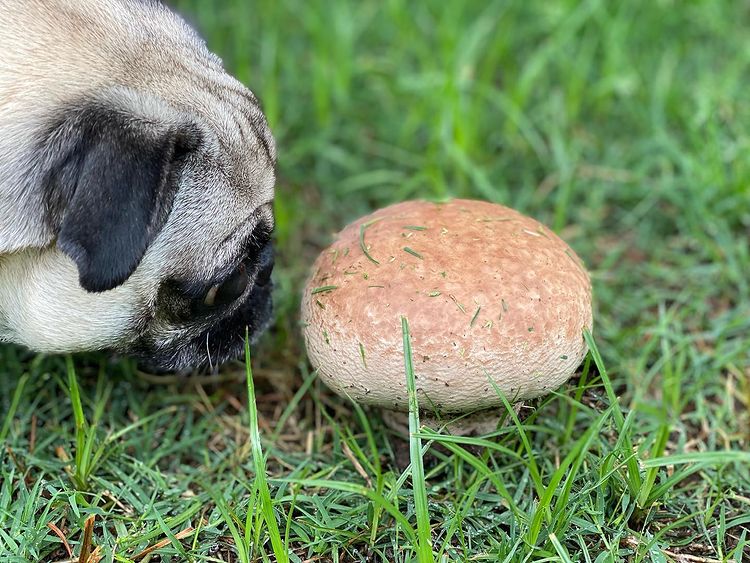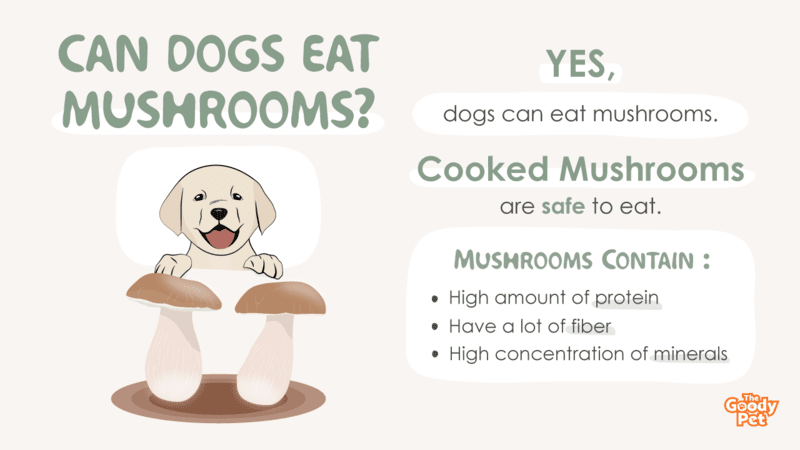I recently saw a dog happily wolf down a wild mushroom from the ground. It got me thinking if the canine’s digestive system managed to process the fungi safely. It also got me wondering if mushrooms are good or harmful to dogs. So can dogs eat mushrooms, and if so, cooked or raw?
Dogs should eat cooked mushrooms as long as they are safe to eat. Like humans, dogs can suffer from mushroom poisoning if they eat the wrong ones. Therefore, whether you go to the emergency room or not solely depends on the type of mushroom your dog eats.
Some mushrooms have health benefits for dogs. Below, you will find a list of mushrooms safe for your dog to eat. Additionally, you can learn how to introduce mushrooms to your dog’s diet safely. But first, let us take a look at what could happen if your dog eats raw mushrooms.
What Happens If A Dog Eats A Raw Mushroom?
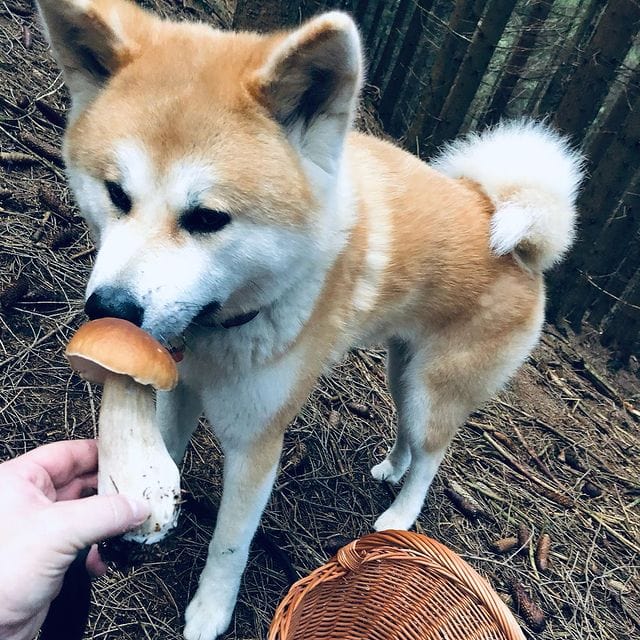
When your dog eats a raw mushroom, whether wild or bought from the grocery store, it can develop symptoms similar to mushroom poisoning in humans. Some mushrooms are toxic and even deadly to dogs, especially wild mushrooms.
Symptoms of mushroom poisoning in dogs vary according to the mushroom they ate. Below are some of the symptoms you can expect from your dog after consuming raw mushrooms.
Amanita Mushroom Poisoning Symptoms
The most common Amanita mushroom is red, with white spots. It frequently grows in the woods and other places with favorable conditions. Therefore, when you take your dog for a walk, they may come across it and consume it.
When your dog consumes a toxic type of Amanita mushroom, it will develop severe gastrointestinal issues. This includes diarrhea, constipation, increased flatulence, vomiting, and a lack of appetite. Some dogs also experience sedation, tremors, and seizures.
Ingestion of this mushroom is fatal without medical attention. This is promptly followed by a false recovery period, where your puppy seems to be feeling better. But without medical assistance, it graduates to liver failure and kidney injury.
Ivory Funnel Mushroom Poisoning
Ivory funnel mushrooms, or Clitocybe dealbata, are small funnel-shaped toadstools. They often grow in lawns, parks, and open areas with favorable conditions. They can be white or ivory. Unfortunately, ingestion of even one of these mushrooms is lethal to dogs.
Your dog will develop watering eyes, increased urination, diarrhea, unusual salivation, lack of appetite, constipation, and neurological upset. You will notice distress and restlessness in your companion.
Other Mushroom Poisoning Symptoms
Other mushrooms toxic to dogs include:
- Galerina marginata (deadly Galerina)
- Amanita gemmata (jeweled death cap)
- Gyromitra species (false morel)
- Inocybe species mushrooms
Sometimes, you may not be able to identify the mushroom that your dog ate. Some dogs even eat mushrooms without the knowledge of their owners. In both situations, remain observative, looking out for the following symptoms:
- Uncoordinated balance (walking drunk)
- Weakness
- Reduced movement
- Remaining in one position
- Vomiting
- Diarrhea
- Constipation
- Seizures
- Reduced appetite
Treatment for mushroom poisoning is going straight to the vet. Do not try to induce vomiting in your companion. Instead, take your puppy to the vet for assessment and treatment.
If you can, take a photo of the mushroom your pet ate and show it to the vet. Treatment varies from mushroom to mushroom. Therefore, a photo or a good description of the mushroom should help.
What Kinds Of Mushrooms Can Dogs Eat?
Dogs can eat store-bought mushrooms that are safe for human consumption. So if you are thinking about introducing mushrooms to your dog’s diet, get the following mushrooms:
White Button
These mushrooms are white when immature and brown when mature. They grow worldwide in grassy fields, especially after the rain. You will also find them in grocery stores and food markets. They have a round white cap that looks like a button.
Portobello
A portobello mushroom has a wide and flat brown cap that can reach up to 5 inches in diameter. They grow individually, near manure piles in the grass. You will also find them near conifers such as cypress trees.
Maitake
This type of mushroom grows in large clusters in tree stumps and tree roots. This mushroom cluster has flattened brown caps with white edges. From a distance, the cluster looks like ruffled feathers.
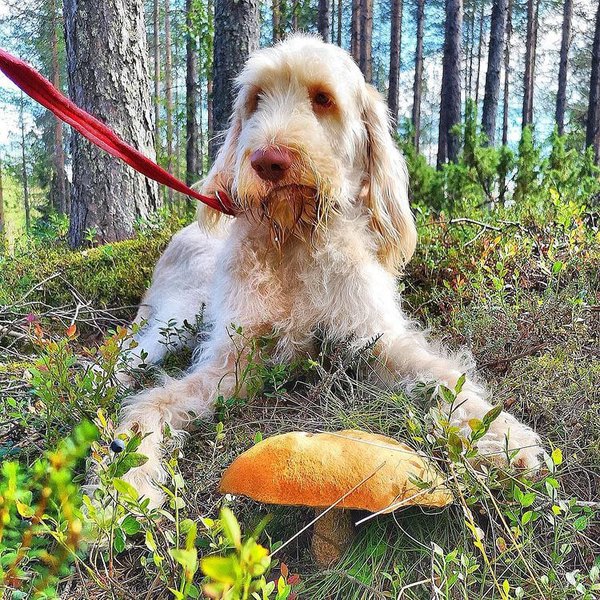
Reishi
This mushroom has a wide kidney-shaped cap, like a fan. The cap has a shiny reddish-orange color. It has no gills and is white underneath. You will find these mushrooms in forested areas, growing on dead or dying trees.
Cremini
This mushroom is dark brown and feels firmer. It has a smooth cap, with thin skin covering its gills underneath. When shopping, always check that the gills have the sheath skin covering because it indicates freshness.
Shiitake
This mushroom has a large dark brown cap with a slender cream stem. It easily resembles a practical umbrella. Shiitake mushrooms often grow on the decaying wood of deciduous trees, such as maple, oak, sweetgum, and chestnut.
Porcini
Like the Shiitake mushrooms, Porcini mushrooms have a tan to dark brown cap with a cream-colored stem. The under cap is solid, white, and firm. They grow in small clusters near trees and forests.
Most of these options are available in local grocery stores and food markets.
Are Cooked Mushrooms OK For Dogs?
Cooked mushrooms are safe for dogs to eat because cooking eliminates any live bacteria found on the mushrooms, which would otherwise cause stomach upsets when consumed.
In addition, always remember never to cook wild mushrooms to serve them to your dog. Instead, go for store-bought mushrooms that are certified safe for your dog or you to eat. When you prepare them well, these will not harm your dog’s digestive health.
Some mushrooms have a high amount of protein to help your dog grow. In comparison, others have a lot of fiber, enhancing digestion and preventing constipation. Others are popular for their high concentration of minerals such as iron, magnesium, and manganese.
Some are also rich in antioxidants, which survive even after cooking. They help to improve your dog’s overall health. The trick with mushrooms is to prepare them well. You can learn more about introducing mushrooms to your dog safely below.
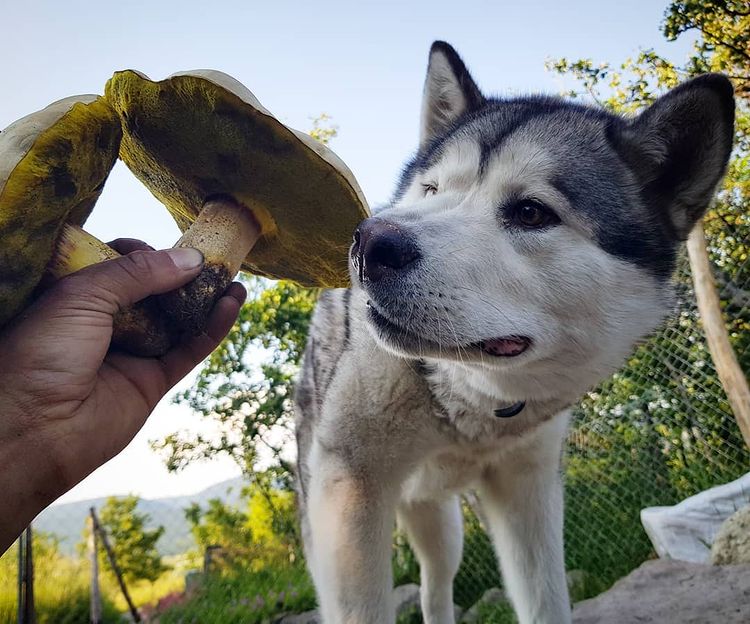
How To Feed Mushrooms To Your Dog Safely?
To feed mushrooms to your dog safely, ensure that you wash them thoroughly under clean running water. Wipe them on a clean, dry towel to see if any dirt remains. Always cook the mushrooms and serve them plain to prevent negative reactions.
Since most people rarely serve plain mushrooms, they put dogs at risk of gastrointestinal distress. People cook mushrooms with oil, butter, seasoning, and vegetables, such as onions and garlic.
Letting your dog eat off your plate exposes them to harmful food items that will bring gastrointestinal symptoms. Therefore, it is better to serve your dog plain mushrooms using the following instructions.
Basic Mushroom Recipe For Dogs
- Chop the mushrooms into sizable portions.
- Cook them in a pan using safe cooking oil for dogs, such as olive oil.
- Do not add any seasoning or spices.
- You can add a little dog-friendly chicken or beef broth for flavor.
- Stir until the mushrooms absorb the broth.
- Serve them on their own.
Like other treats and dog food, ensure that you serve mushrooms in moderation. They should only be about 10% or less of their total diet. Too many mushrooms can upset your dog’s digestive system. Additionally, if you notice any side effects, discontinue feeding your canine mushrooms.
